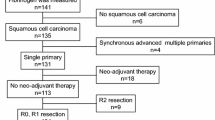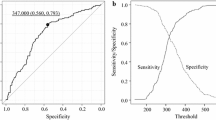Abstract
Purpose
Hyperfibrinogenemia is associated with unfavorable prognosis and advanced tumor behavior in various malignancies, including esophageal squamous cell carcinoma (ESCC). However, its biological function in ESCC is unknown. The present study was designed to further validate the prognostic value of preoperative plasma hyperfibrinogenemia and evaluate the biological role of fibrinogen, as well as the underlying mechanism in ESCC.
Methods
Data from 452 cases with newly diagnosed ESCC followed by curative surgery between 2006 and 2010 were retrospectively evaluated. The Clauss method was utilized to measure the preoperative plasma fibrinogen level. Correlations between the fibrinogen level and clinicopathologic characteristics and survival analysis were performed. The effects of fibrinogen on malignant behaviors, including tumor cell viability, colony formation, migration, and invasion, were also investigated.
Results
The optimal cut-off value for plasma fibrinogen level was defined as 4.0 g/L according to recommendations. Thus, the proportion of hyperfibrinogenemia was 24.8% (112/452). Preoperative plasma hyperfibrinogenemia was significantly associated with advanced tumor length, deep tumor invasion, advanced tumor–node–metastasis stage, alcohol consumption, a higher white blood cell count, a higher platelet count, and high globulin levels. Univariate survival analysis revealed that compared to those with normal plasma fibrinogen levels, patients with hyperfibrinogenemia tended to have poorer disease-free survival (DFS) [hazard ratio (HR), 1.692; 95% confidence interval (CI), 1.304–2.196; P < 0.001] and overall survival (OS) (HR 1.864; 95% CI 1.424–2.440; P < 0.001). In the multivariate Cox regression models, these factors remained independent predictors for impaired DFS (HR 1.491; 95% CI 1.138–1.955; P = 0.004) and OS (HR 1.648; 95% CI 1.246–2.180; P < 0.001) after adjusting for other confounding variables. In addition, fibrinogen could significantly promote cell migration and invasion but not proliferation. Moreover, it could also induce epithelial–mesenchymal transition (EMT) and increase the levels of p-PTEN, p-AKT, and p-mTOR in ESCC cell lines.
Conclusions
Preoperative plasma hyperfibrinogenemia might serve as an independent predictor of unfavorable survival in ESCC. Furthermore, fibrinogen may promote cell motility by inducing EMT via the p-AKT/p-mTOR pathway.




Similar content being viewed by others
References
Arigami T, Okumura H, Matsumoto M, Uchikado Y, Uenosono Y, Kita Y et al (2015) Analysis of the fibrinogen and neutrophil-lymphocyte ratio in esophageal squamous cell carcinoma. Medicine (Baltimore) 94:e1702
Arnold M, Soerjomataram I, Ferlay J, Forman D (2015) Global incidence of oesophageal cancer by histological subtype in 2012. Gut 64:381–387
Chen M, Huang J, Zhu Z, Zhang J, Li K (2013) Systematic review and meta-analysis of tumor biomarkers in predicting prognosis in esophageal cancer. BMC Cancer 13:539
Dutta S, Crumley AB, Fullarton GM, Horgan PG, McMillan DC (2011) Comparison of the prognostic value of tumour- and patient-related factors in patients undergoing potentially curative resection of oesophageal cancer. World J Surg 35:1861–1866
Edge SB, Compton CC (2010) The American Joint Committee on Cancer: the 7th edition of the AJCC cancer staging manual and the future of TNM. Ann Surg Oncol 17:1471–1474
Engelman JA (2009) Targeting PI3 K signalling in cancer: opportunities, challenges and limitations. Nat Rev Cancer 9:550–562
Ferlay J, Shin HR, Bray F, Forman D, Mathers C, Parkin DM (2008) Estimates of worldwide burden of cancer in 2008: globocan 2008. Int J Cancer 127:2893–2917
Guo R, Meng Q, Guo H, Xiao L, Yang X, Cui Y et al (2016) TGF-β2 induces epithelial-mesenchymal transition in cultured human lens epithelial cells through activation of the PI3 K/Akt/mTOR signaling pathway. Mol Med Rep 13:1105–1110
Kinoshita A, Onoda H, Imai N, Iwaku A, Oishi M, Tanaka K et al (2013) Elevated plasma fibrinogen levels are associated with a poor prognosis in patients with hepatocellular carcinoma. Oncology 85:269–277
Kohnoh T, Hashimoto N, Ando A, Sakamoto K, Miyazaki S, Aoyama D et al (2016) Hypoxia-induced modulation of PTEN activity and EMT phenotypes in lung cancers. Cancer Cell Int 16:33
Li L, Liu D, Qiu X, Zhao S, Zhang L, Li WM (2015) The prognostic role of mTOR and p-mTOR for survival in non-small cell lung cancer: a systematic review and meta-analysis. PLoS One 10:e0116771
Lin Y, Totsuka Y, He Y, Kikuchi S, Qiao Y, Ueda J et al (2013) Epidemiology of esophageal cancer in Japan and China. J Epidemiol 23:233–242
Luzzatto G, Schafer AI (1990) The prethrombotic state in cancer. Semin Oncol 17:147–159
Lyman GH, Khorana AA (2009) Cancer, clots and consensus: new understanding of an old problem. J Clin Oncol 27:4821–4826
Matsuda S, Takeuchi H, Fukuda K, Nakamura R, Takahashi T, Wada N et al (2014) Clinical significance of plasma fibrinogen level as a predictive marker for postoperative recurrence of esophageal squamous cell carcinoma in patients receiving neoadjuvant treatment. Dis Esophagus 27:654–661
McMillan DC (2013) The systemic inflammation-based Glasgow Prognostic Score: a decade of experience in patients with cancer. Cancer Treat Rev 39:534–540
Mosesson MW (2005) Fibrinogen and fibrin structure and functions. J Thromb Haemost 3:1894–1904
Odriozola L, Singh G, Hoang T, Chan AM (2007) Regulation of PTEN activity by its carboxyl-terminal autoinhibitory domain. J Biol Chem 282:23306–23315
Paramanathan A, Saxena A, Morris DL (2014) A systematic review and meta-analysis on the impact of pre-operative neutrophil lymphocyte ratio on long term outcomes after curative intent resection of solid tumours. Surg Oncol 23:31–39
Rahdar M, Inoue T, Meyer T, Zhang J, Vazquez F, Devreotes PN (2009) A phosphorylation-dependent intramolecular interaction regulates the membrane association and activity of the tumor suppressor PTEN. Proc Natl Acad Sci 106:480–485
Sahni A, Francis CW (2000) Vascular endothelial growth factor binds to fibrinogen and fibrin and stimulates endothelial cell proliferation. Blood 96:3772–3778
Sheng L, Luo M, Sun X, Lin N, Mao W, Su D (2013) Serum fibrinogen is an independent prognostic factor in operable nonsmall cell lung cancer. Int J Cancer 133:2720–2725
Shu YJ, Weng H, Bao RF, Wu XS, Ding Q, Cao Y et al (2014) Clinical and prognostic significance of preoperative plasma hyperfibrinogenemia in gallbladder cancer patients following surgical resection: a retrospective and in vitro study. BMC Cancer 14:566
Siegel RL, Miller KD, Jemal A (2015) Cancer statistics. CA Cancer J Clin 65:5–29
Son HJ, Park JW, Chang HJ, Kim DY, Kim BC, Kim SY et al (2013) Preoperative plasma hyperfibrinogenemia is predictive of poor prognosis in patients with nonmetastatic colon cancer. Ann Surg Oncol 20:2908–2913
Takeuchi H, Ikeuchi S, Kitagawa Y, Shimada A, Oishi T, Isobe Y et al (2007) Pretreatment plasma fibrinogen level correlates with tumor progression and metastasis in patients with squamous cell carcinoma of the esophagus. J Gastroenterol Hepatol 22:2222–2227
Tang L, Liu K, Wang J, Wang C, Zhao P, Liu J (2010) High preoperative plasma fibrinogen levels are associated with distant metastases and impaired prognosis after curative resection in patients with colorectal cancer. J Surg Oncol 102:428–432
Tennent GA, Brennan SO, Stangou AJ, O’Grady J, Hawkins PN, Pepys MB (2007) Human plasma fibrinogen is synthesized in the liver. Blood 109:1971–1974
Wang H, Gao J, Bai M, Liu R, Li H, Deng T et al (2014) The pretreatment platelet and plasma fibrinogen level correlate with tumor progression and metastasis in patients with pancreatic cancer. Platelets 25:382–387
Wang J, Liu H, Shao N, Tan B, Song Q, Jia Y et al (2015) The clinical significance of preoperative plasma fibrinogen level and platelet count in resectable esophageal squamous cell carcinoma. World J of Surg Oncol 13:157
Wei XL, Wang FH, Zhang DS, Qiu MZ, Ren C, Jin Y et al (2015) A novel inflammation-based prognostic score in esophageal squamous cell carcinoma: the C-reactive protein/albumin ratio. BMC Cancer 15:350
Xiong JB, Li ZR, Zhang Y, Li DJ, Zhang GY, Luo XS et al (2016) PRL-3 promotes the peritoneal metastasis of gastric cancer through the PI3 K/Akt signaling pathway by regulating PTEN. Oncol Rep 36:1819–1828
Yoshioka A, Miyata H, Doki Y, Yasuda T, Yamasaki M, Motoori M et al (2008) The activation of Akt during preoperative chemotherapy for esophageal cancer correlates with poor prognosis. Oncol Rep 19:1099–1107
Zhang D, Zhou X, Bao W, Chen Y, Cheng L, Qiu G et al (2015) Plasma fibrinogen levels are correlated with postoperative distant metastasis and prognosis in esophageal squamous cell carcinoma. Oncotarget 6:38410–38420
Zheng S, Shen J, Jiao Y, Liu Y, Zhang C, Wei M et al (2009) Platelets and fibrinogen facilitate each other in protecting tumor cells from natural killer cytotoxicity. Cancer Sci 100:859–865
Author information
Authors and Affiliations
Corresponding author
Ethics declarations
Funding
None.
Conflict of interest
The authors declare that they have no conflict of interest.
Electronic supplementary material
Below is the link to the electronic supplementary material.
432_2017_2493_MOESM1_ESM.tif
Fibrinogen demonstrates no effect on the proliferation or colony-formation ability of ESCC cells. (A) The viability of HKESC (left panel) and Eca109 (right panel) exposed to fibrinogen (72 h) was detected with an MTT assay. (B) The viability of the indicated cells treated with fibrinogen (0, 50, 200, and 400 μg/ml) at the indicated timepoints. (C) Images (left panel) and quantification (right panel) of colony formation of the indicated cells cultured with fibrinogen at different concentrations for 14 days (TIFF 3019 kb)
Rights and permissions
About this article
Cite this article
Zhang, F., Wang, Y., Sun, P. et al. Fibrinogen promotes malignant biological tumor behavior involving epithelial–mesenchymal transition via the p-AKT/p-mTOR pathway in esophageal squamous cell carcinoma. J Cancer Res Clin Oncol 143, 2413–2424 (2017). https://doi.org/10.1007/s00432-017-2493-4
Received:
Accepted:
Published:
Issue Date:
DOI: https://doi.org/10.1007/s00432-017-2493-4




